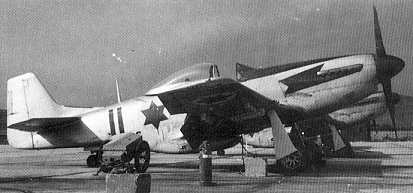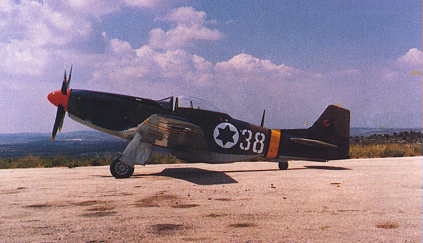
 It was Reichmarschall Hermann Goering, head of Nazi Germany's Luftwaffe,
who said "When I saw those Mustangs over Berlin, I knew that the war was lost". The best fighter of the Second World
War was designed as a private venture and developed for a foreign customer which doubted the company could even
build a good fighter. Contacted by Britain to produce the second-rate Curtiss P-40 for the RAF, North American Aviation
(NAA) proposed to build a new fighter for the British. Only in May 1940, 8 monthes after the contacts between the two
sides begun did Britian sign a contract for the new fighter, and even then under strict limitations. The prototype was
completed within 102 days and its performance was better than that of any European counterpart of the time, flying faster
and carrying more fuel. The initial RAF order of 320 aircraft was soon followed by a further order for another 300, and
the type was to become the first RAF fighter to overfly Nazi Germany during the war. The Mustang was soon ordered
for the U.S. Army and dominated the sky over Europe, not only in Western Europe but also over the Eastern and Italian
fronts as well as in the Pacific theatre. The most numerous variant was the D model, incorporating a bubble canopy and
even more fuel than its predecessors. Mustangs continued to serve with U.S. well into Korean war and served in over
50 air forces around the world.
It was Reichmarschall Hermann Goering, head of Nazi Germany's Luftwaffe,
who said "When I saw those Mustangs over Berlin, I knew that the war was lost". The best fighter of the Second World
War was designed as a private venture and developed for a foreign customer which doubted the company could even
build a good fighter. Contacted by Britain to produce the second-rate Curtiss P-40 for the RAF, North American Aviation
(NAA) proposed to build a new fighter for the British. Only in May 1940, 8 monthes after the contacts between the two
sides begun did Britian sign a contract for the new fighter, and even then under strict limitations. The prototype was
completed within 102 days and its performance was better than that of any European counterpart of the time, flying faster
and carrying more fuel. The initial RAF order of 320 aircraft was soon followed by a further order for another 300, and
the type was to become the first RAF fighter to overfly Nazi Germany during the war. The Mustang was soon ordered
for the U.S. Army and dominated the sky over Europe, not only in Western Europe but also over the Eastern and Italian
fronts as well as in the Pacific theatre. The most numerous variant was the D model, incorporating a bubble canopy and
even more fuel than its predecessors. Mustangs continued to serve with U.S. well into Korean war and served in over
50 air forces around the world.
Although the War of Independence ended in early 1949, the Mustangs continued to fly reconnaissance missions
over neighbouring Arab states for a number of years. Beyond the four original Mustangs, the latter pair assembled by
now, more examples were acquired for the IAF. 36 more aircraft were purchased in the U.S. in the early fifties, and in 1952
Israel bought 25 examples from the Swedish Air Force (example 19 below was one of them), among which were four
tactical reconnaissance Mustangs. In 1955 30 more aircraft were purchased in Italy, but only some of them were assembled
and flown. With the arrival of the new aircraft, the Mustang became the backbone of Israel's fighter force, performing
such tasks as bomber escort, ground attack and maritime patrol.
The Mustangs went into action again on April 5th, 1951, when
4 P-51s and 4 Spitfires attacked the Syrian police station and army camp at El-Hama after Syrian forces ambushed and killed 7 Israeli soldiers. When an Israel Navy ship ran
aground near Saudi Arabia in April 1954, Mustangs were sent at first to protect the rescue operations and later to bomb
the ship and destroy it before it fell into enemy hands. In October 1956, shortly before the outebreak of the Suez crisis,
4 Mustangs bombed the Jordanian police station at Kalkillia.
In the early 1950s the IAF began arming itself with jet fighters such as the Meteor, Ouragan, and Mystere, and the
Mustang lost its frontline role, a large number sent into storage in 1956. Only one squadron remained operational, No 116,
and its primary role was to instruct new pilots. The international circumstances, however, soon dictated the return of
the Mustang to action when in late October 1956 the Suez Crisis broke out. Taken out of storage, a second squadron
was formed and a total of 48 Mustangs were in operation. Given their long operational range, the Mustangs were tasked
with destruction of Egyptian fighters and bombers at distant airfields, some even beyond the Suez Canal in mainland
Africa.
On the day hostilites broke out, October 29th, two pairs of P-51Ds were assigned a special mission - to disrupt Egyptian
communication by cutting the phone lines that connected the various Egyptian army camps with their HQ. A special
device was designed specifically for this mission, consisting of a weight connected by a cable to the aircraft's tail. The
Mustangs took to the air at noon, but by the time they had arrived at their targets, some had lost the cable. Instead of
aborting their mission, these Mustangs cut down the phone lines using their wings and propellers, with considerable
risk to themselves.

For the Mustangs, the war begun differently than planned. In the first two days, IAF command refused to allow piston engined aircraft to enter the fighting zone before the establishment of air superiority. Only on October 31st did the Mustangs join in the fighting and until the end of the war were used to attack enemy forces, outposts, fortifications, routes, shipping and other such targets. All in all, the Mustangs carried out 184 sorties, during which 7 aircraft were lost, including No. 19 (above) lost near Sharm-A-Sheik in the southern Sinai Peninsula.
With the prolifiration of jet aircraft both in the IAF and Arab air forces, and the advances made in anti aircraft weaponry, the P-51D Mustang became obsolete and the type was finally retired from service on January 15th, 1961. The IAF's last frontline piston engined fighter, a total of 79 Mustangs served with the Israeli Air Force. The Mustang, along with the Mosquito, is also of great historical importance - in operating these aircraft , the IAF developed the concept of using multi-role fighters in both interception and ground attack roles in order to maximise the capabilities of a limited fighter arm (A concept relevant even today with aircraft such as the F-4 and F-16). Four examples still survive in Israel today, all of them at the IAF Museum at Hatzerim which still maintains one in flying condition.

 back to the IDF/AF page
back to the IDF/AF page